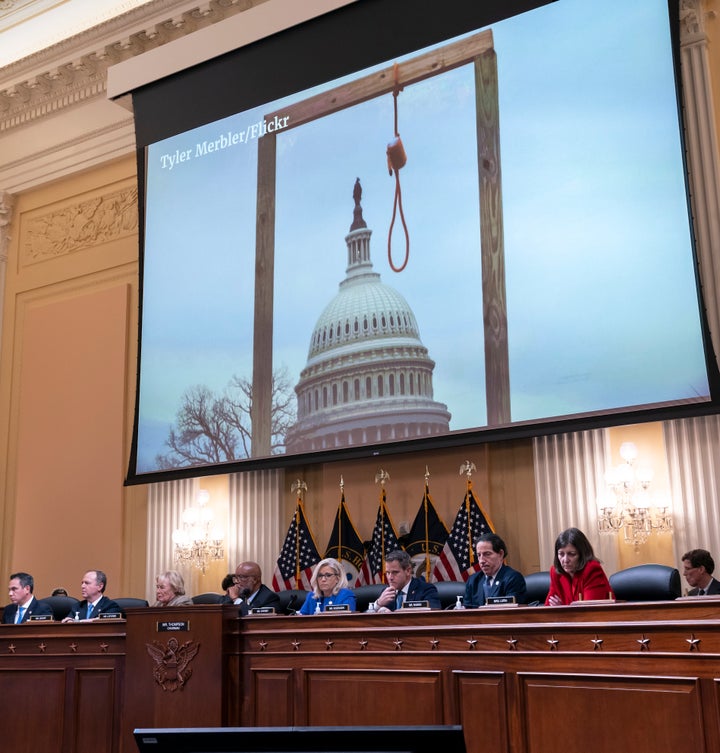WASHINGTON — Donald Trump’s last-gasp scheme to overturn democracy and remain in power put his own vice president’s life in grave peril, as Trump’s social media attack on Mike Pence further enflamed the mob that had already breached the U.S. Capitol, the House Jan. 6 committee detailed in a hearing Thursday that included the revelation that the pro-Trump Proud Boys group was prepared to murder Pence on that day.
Committee chair Bennie Thompson, a Mississippi Democrat, said Pence himself explained in a recent speech that it was “un-American” to do what Trump wanted.
“Mike Pence said no. He resisted the pressure. He knew it was illegal. He knew it was wrong,” Thompson said.
The pressure on Pence, which Trump had been applying in both private and public for weeks, continued even on Jan. 6 itself, with a late morning phone call Trump initiated.
The call became “heated,” according to testimony revealed Thursday, with one former Trump aide telling investigators that he heard Trump call Pence “a wimp” and say he had “made the wrong decision” five years earlier when he chose Pence as his running mate. An aide to daughter Ivanka Trump said she was upset because Trump had called Pence “the ‘P’ word.”
Just three hours later, after Pence publicly announced he would not do as Trump wanted, Trump tweeted an attack on Pence, claiming the vice president “didn’t have the courage” to do what was necessary.
“Donald Trump turned the mob on him,” Thompson said.
The committee revealed evidence from the Department of Justice’s investigation into the Proud Boys extremist group that a witness has sworn that “they would have killed Mike Pence if given the chance.”
Committee member Peter Aguilar, a California Democrat, showed a video illustrating how close the pro-Trump attackers got to Pence, his staff and his family as the Secret Service hustled them to safety. “Approximately 40 feet. That’s all there was,” Aguilar said. “Forty feet between the vice president and the mob.”
As the panel had done in the other two hearings in the past week, it shared testimony from Trump’s own inner circle to show how damning Trump’s actions were in the weeks leading up to the Capitol assault and on that day itself.
On Thursday, it came from Greg Jacob, the former counsel to Pence at the White House who testified in person, and from former Pence chief of staff Marc Short, who provided videotaped testimony.
Both were with Pence in the Capitol on Jan. 6, and Jacob told the committee he had not realized how close the attackers had gotten. “I could hear the din of the rioters in the building as we moved, but I wasn’t aware they were as close as that,” he said.
Also appearing in person was J. Michael Luttig, the retired federal appellate judge who, at the request of Pence, helped him with a statement that was released as Trump was still speaking at his pre-insurrection rally near the White House on Jan. 6.
Luttig told the committee that had Pence “obeyed the orders from his president,” it would have thrown the country into the first true constitutional crisis since the founding. “That declaration of Donald Trump as the next president would have plunged America into what I believe would have been tantamount to a revolution within a constitutional crisis,” Luttig testified Thursday.

Integral to Trump’s plan were the slates of fake, pro-Trump electors that Trump’s campaign began organizing not long after his loss was confirmed. These groups met in seven states won by Joe Biden on Dec. 14, 2020, the day of the Electoral College vote, to send fraudulent Trump ballots to Washington, D.C.
The strategy was for Pence, having before him “competing slates” of electors from these states, to invalidate all of them, leaving Trump with a majority of electoral votes from the remaining states — which would let Pence award Trump a second term. Alternatively, Pence could send the ballots back to the states, where GOP-controlled legislatures would override the popular votes in those states and declare Trump the winner.
That theory was pushed by a group of pro-Trump lawyers, led by John Eastman, who were pressing Pence to act unilaterally.
Jacob, who had been conducting an extended argument with Eastman on the topic, said his own research into the Constitution and the 1887 Electoral Count Act made it clear that the drafters of the Constitution, having recently broken free of a tyrannical king of England, would not have put such power into the hands of the vice president.
“There was no way they would have put it in the hands of one person to determine who would be the president of the United states,” Jacob testified Thursday.
Luttig said Eastman was simply wrong. “There was no basis in the Constitution or laws of the United States for the theory espoused by Mr. Eastman at all. None,” he said.
Pence, in any event, refused to go along with the scheme, and in the days leading up to Jan. 6 enlisted the help of Luttig, a longtime icon in conservative legal circles who was considered for the U.S. Supreme Court by former President George W. Bush.
Luttig on Jan. 5 posted a series of tweets explaining why Pence had no authority to do what Trump was demanding. “The Constitution does not empower the vice president to alter in any way the votes that have been cast, either by rejecting certain of them or otherwise,” Luttig wrote.
Pence’s team then cited that Twitter thread in the letter he released to Congress and the public at the start of the certification ceremony on Jan. 6.
The committee on Thursday revealed that Eastman, in the closing days of Trump’s tenure, asked Trump adviser Rudy Giuliani for a pardon. “I’ve decided I should be on the pardon list, if that is still in the works,” an email displayed by the committee read.
Committee member Peter Aguilar, a California Democrat, then showed video of Eastman repeatedly claiming the Fifth Amendment right to not incriminate himself in his deposition before committee investigators. “Dr. Eastman pled the Fifth 100 times,” Aguilar said.
The bipartisan committee is nearly halfway through a series of public hearings intended to lay out Trump’s role in stoking anger among his millions of followers following his election loss and then inviting them to Washington, D.C., for the express purpose of intimidating Pence and lawmakers into letting him remain in power anyway.
Trump, despite losing the election by 7 million votes nationally and 306-232 in the Electoral College, became the first president in more than two centuries of elections to refuse to hand over power peacefully. He spurred on the Jan. 6 Capitol riot — a last-ditch attempt to remain in office — which led to five deaths, including one police officer, injuries to an additional 140 officers and four police suicides.
Nevertheless, Trump remains the dominant figure in the Republican Party and is openly speaking about running for the presidency again in 2024.
Based on that, Luttig offered the committee and the country a warning near the hearing’s close: “Donald Trump and his allies and supporters, are a clear and present danger to American democracy,” he said. “I don’t speak those words lightly.”
